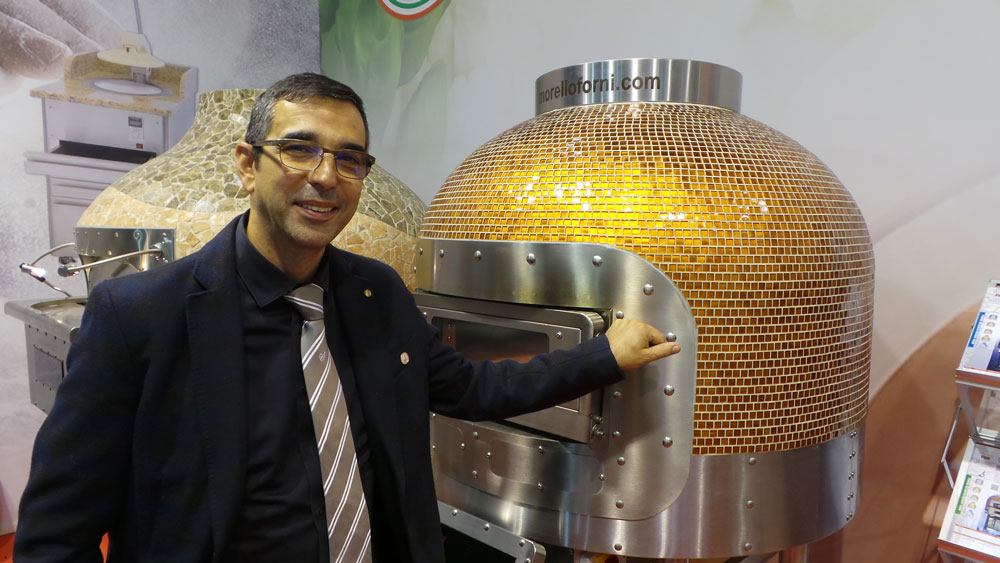- The pandemic and last year’s stay-at-home orders brought about some key changes to Italian pizza culture, including the expansion of Contemporary Neapolitan Pizza.
- For years before COVID-19, some Italian pizza makers had already been challenging Neapolitan pizza’s stringent rules that define authenticity.
Related: Neapolitan pizza gives us something to be thankful for
Story & Photos by Missy Green
Italians may have invented pizza, but it was Americans who came up with pizza delivery. Putting a pizza in a cardboard box and bringing it to customers’ homes was first popularized in the U.S., where it became a model for the rest of the world.
In Italy, meanwhile, pizza has long persisted as either a dine-in affair or an on-the-go street food. Classics like a traditional Neapolitan or a Roman-style square sold by weight are finished off in the oven just before being served hot and fresh. But all that changed with the rise of COVID-19 and the subsequent stay-at-home orders.

Marco Morello, president of Morello Forni.
Revising Italian Culture
Social distancing came in direct opposition to many aspects of Italian life, including the way people gather in groups to eat. Without customers dining in the store or passing by on the street, the minds behind the Italian pizza industry had to rethink how they create, bake and serve their most beloved food.
“One of the latest innovations in the Italian pizza industry is Contemporary Neapolitan pizza,” says Marco Morello, president of Genoa, Italy-based oven company Morello Forni. He describes the innovative style as a “revisiting” of the Neapolitan product, one that better pairs with the modern demands for pizza delivery and increased takeaway.
“Classic Neapolitan pizza—which is a beautiful and fantastic product—loses its most important characteristics as soon as it’s put in a box for delivery,” Morello says. Contemporary Neapolitan pizza, on the other hand, has a longer cooking time, creating a product that’s crunchier, he adds. This enables the pizza to be delivered while preserving the esthetics of a true Neapolitan pie.
While Contemporary Neapolitan pizza was gaining attention before the pandemic, Morello notes that “it wasn’t that popular.” The pandemic helped it grow because it provided an opportunity: the ability to sell pizza for delivery at a time when restaurants were struggling.
Italian-born U.S. Pizza Team member Pasquale di Maio, the owner of Vesuvio’s Mobile Wood Fired Pizza in Minneapolis, names another benefit to the new take on the classic. “Contemporary Neapolitan pizza is much easier to digest,” he says. “It has a higher hydration of 70% water and a longer fermentation time.”
Di Maio’s catering outfit brings the modernized pie to weddings, corporate events and other high-volume activities. But he doesn’t distinguish between his version and classic varieties, and most pizzerias in Italy don’t, either.
Related: Gianni Gallucci shares the secrets of gluten-free Neapolitan-style pizza
A Silent Pizza Revolution?
Morello explains that, during the pandemic, pizzerias didn’t actively promote the fact that they had “evolved” their recipes, and the transition from Classic Neapolitan to Contemporary Neapolitan stayed largely under the radar. “Pizzerias during COVID were more focused on keeping their heads above water than they were on informing customers about their unique method of making pizza,” he says. “It was more important to actually make it than philosophize about how it is defined.”
While there was nothing dubious about this silent pizza revolution, it’s noteworthy that, for years before COVID-19, some Italian pizza makers had been challenging Neapolitan pizza’s stringent rules that define authenticity or “STG” (“specialità tradizionale garantita,” or “traditional specialty guaranteed” in English).
For example, despite STG’s requirements for “true” Neapolitan pizza to be cooked in a wood-fired oven, this is often simply impractical, di Maio says. “Working with a wood-burning oven is a very skilled job that requires a lot of training. An electric oven keeps a uniform temperature in every corner, making it much easier to adapt to employee turnover.” Moreover, changing environmental regulations paint an uncertain future for wood-burning ovens globally.

Pasquale di Maio demonstrated the Caruso electric pizza oven at HostMilano.
Contemporary Ovens for Classic Pies
Of course, when delivering a pizza in its best state, the biggest challenge is controlling the moisture. Taking this into account, Italforni released the Caruso pizza oven at HostMilano at the end of last year. The oven was developed in collaboration with master Neapolitan pizza chefs and is positioned as “the first electric oven with the same performance as a traditional wood-burning oven,” reaching 986°F.
Di Maio demonstrated the oven at the Milan-based restaurant trade show last October, hailing it as “the future of pizza,” in part for its ability to remove excess moisture. “When a pizza comes out of the oven, we normally put it right on a plate or in a box, and we know that the steam released from the bottom will impact the crust,” Di Maio says.
In contrast, the Caruso oven removes steam with an added final step: The pizza maker finishes off the pizza in a special chamber that blows hot air down from the deck and around the pizza, never losing the heat. “I’ve seen other solutions to control moisture, like using a textured plate to lift the pizza up, but you still get a steam layer,” di Maio says. “With this concept of ‘drying the pizza,’ the steam is removed completely.”
Related: This food truck operator has made Neapolitan pizza history in Atlanta

Made with a century-old mother dough, a Scrocchiarella base reduces the time it takes to make authentic pizza al taglio.
Boxing Up Traditional Window Displays
Meanwhile, Italmil, creators of the airy and crunchy pizza base dubbed Scrocchiarella, adapted to the increased focus on delivery by coming out with a round 31-centimeter (12”) base that could fit into a standard pizza box.
Scrocchiarella is made using a mother dough that the company has propagated for more than a century in Bergamo in northern Italy. Its formulation significantly reduces the time to prepare authentic pizza al taglio, the long, air bubble-infused, puffed-up varieties of pizza often seen in to-go display cases around Rome and boasting an array of colorful toppings.
Last October, also at the HostMilano event, Italmil introduced a par-baked black Venus rice variety and a soft wheat Scrocchiarella base to help pizzerias produce high-quality pizza in record time. “When you order a pizza in Italy, especially if it’s a Saturday night, it takes a very long time for your pizza to be delivered,” explains Matteo Bosio, product developer at Italmil. “These bases can help pizzerias deliver faster while keeping the quality high.”

Missy Green tries out a scooter mounted with the RedBox delivery system.
Optimized Delivery
Lastly, how a pizza is handled in transit makes a huge impact on how the final product is presented to the customer. With this in mind, Tuscany-based pizza tool innovator Gi.Metal released RedBox, a delivery system designed to keep a traveling pizza as fresh as the moment it came out of the oven for 30 minutes or more. The scooter-mountable box, which also can be installed in most cars, features a heating element to keep pizzas actively warm as well as humidity control to prevent steam buildup.
“The last mile is very frustrating for pizzaioli,” says Marco d’Annibale, CEO at Gi.Metal. “What we offer with the RedBox allows pizzerias to deliver their product hot and dry like never before.”
D’Annibale says the company had this innovation in the pipeline before the pandemic struck, but the emergence of the virus accelerated it onto the market. “What we see is that delivery isn’t going away. It’s become a habit for many of us, so quality in delivery is very important.”
For Morello, the pandemic taught Italy something that Americans learned a long time ago—pizza is one of the best products for delivery. “Here in Italy, we have sushi and hamburger places that offer delivery, too, but pizza is fast food par excellence for us,” he says. “It remains the No. 1 for Italians.”
Missy Green is PMQ’s overseas correspondent.













